Teaching your dog to poop on a pad can be a convenient solution for situations when your dog doesn’t have easy access to the outdoors. Dog potty pads are especially helpful for traveling, leaving your dog at home for extended periods, crate training, house training puppies, and training senior dogs. Using potty pads can prevent accidents and make potty training easier.
Key Takeaways:
- Using potty pads is a convenient solution for situations when your dog can’t go outside.
- Potty pads are helpful for traveling, leaving your dog at home for extended periods, crate training, house training puppies, and training senior dogs.
- Start potty pad training in stages, teaching your dog to go on command and introducing the pad gradually.
- Choose the right pee pads for your dog, considering size, absorbency, and preferences.
- Be patient, consistent, and avoid common potty pad training mistakes.
Why Should I Use Pee Pads?
Pee pads, also known as potty pads, can be beneficial in various situations. They are particularly useful when traveling, as they provide a designated area for your dog to eliminate when outdoor options are limited. Pee pads are also helpful when leaving your dog at home for extended periods and house training puppies. Additionally, they can be used for crate liners and for training senior or incontinent dogs.
Using pee pads can help prevent accidents and make indoor potty training easier. They provide a convenient solution for situations where your dog doesn’t have easy access to the outdoors, such as living in an apartment or during bad weather. Pee pads are designed to be absorbent and leak-proof, ensuring that your floors stay clean and odor-free.
“Pee pads are especially helpful for traveling, leaving your dog at home for extended periods, crate training, house training puppies, and training senior dogs.” – Source: First source
When using pee pads, you should introduce them properly to your dog. Place the pad in a designated area or confined space where your dog usually eliminates. Use a consistent command cue to encourage your dog to use the pad, such as “go potty” or “potty time.” Reward your dog with praise and treats when they successfully use the pee pad.
| Benefits of Pee Pads | Considerations |
|---|---|
|
|
To put it simply, pee pads should not replace outdoor potty training completely. You should continue reinforcing outdoor potty training to teach your dog to eliminate outside. Consistency and positive reinforcement are key to successful potty training, whether you choose to use pee pads or not.
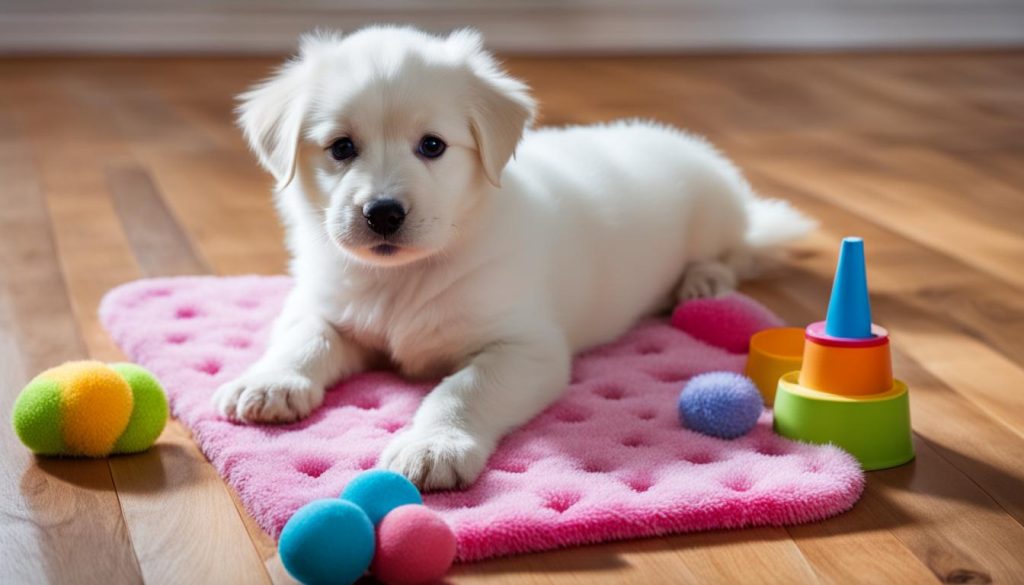
Why Should I Use Pee Pads?
How to Teach a Dog to Use Potty Pads
Teaching your dog to use potty pads can be a convenient solution for situations when your dog doesn’t have easy access to the outdoors. Whether you’re traveling, leaving your dog at home for extended periods, or training a puppy, potty pads can prevent accidents and make potty training easier.
Stage 1: Go to the Bathroom on Command
Start by training your dog to go to the bathroom on command. Use a consistent word cue before your dog eliminates, such as “Go potty” or “Get busy.” This will help your dog associate the cue with the action.
Stage 2: Introduce the Potty Pad
Find a suitable spot for the potty pad, either in a designated area where your dog usually eliminates or in a small confined space for puppy training. Introduce the potty pad to your dog, using a leash if necessary to guide them to it. Encourage your dog to sniff and explore the pad.
Stage 3: Reward and Consistency
When your dog successfully eliminates on the potty pad, reward them with praise, treats, or a favorite toy. Positive reinforcement will help your dog understand that using the potty pad is a desired behavior. Stay consistent with the training, taking your dog to the potty pad frequently and giving them ample opportunities to eliminate.
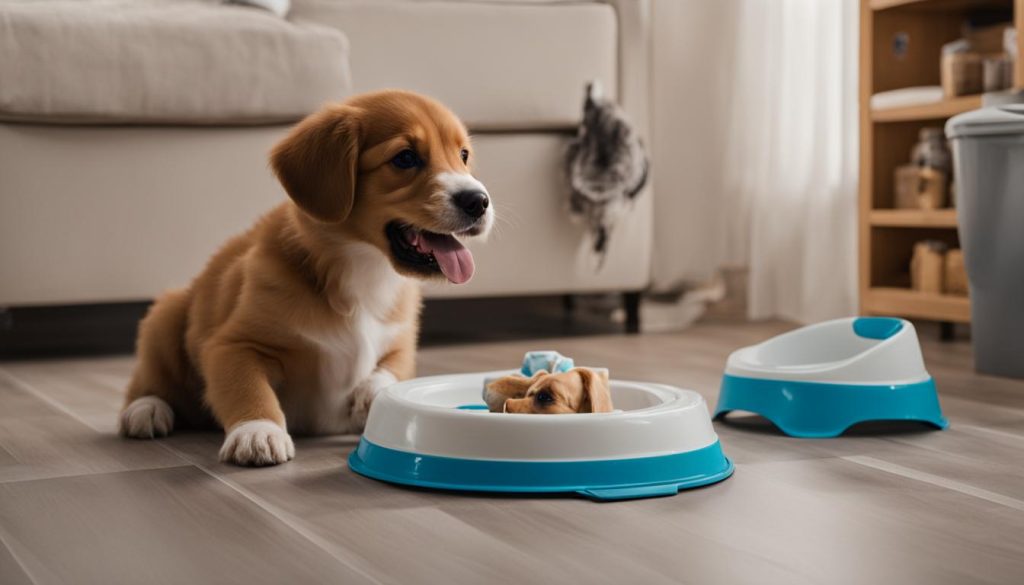
With time and consistency, your dog will learn to use the potty pad consistently. Try to be patient and understanding, as accidents may happen during the training process. Clean up any accidents with an enzymatic cleaner to remove odors and prevent your dog from being tempted to eliminate in the same spot again.
By following these steps and providing positive reinforcement, you can successfully teach your dog to use potty pads and create a convenient solution for their bathroom needs.
What Are the Best Pee Pads for My Dog?
When it comes to choosing the best pee pads for your dog, there are several factors to consider. First and foremost, you want to ensure that the pads are absorbent and leak-proof, preventing any messes from seeping through to your floors. It’s also important to find pads that are large enough to give your dog ample space to target the pad accurately.
Frisco Extra Large Dog Training & Potty Pads are a popular option among pet owners. These pads come in three different sizes and offer excellent absorbency, making them suitable for dogs of all sizes. They are fully lined and leak-proof, giving you peace of mind knowing that your floors are protected.
For dogs who prefer a grass-like surface for elimination, the Four Paws Wee-Wee Dog Grass Patch Tray is a great choice. This realistic-looking grass patch provides a natural feel for your dog and encourages them to use the designated area. The tray is easy to clean and maintain, making it a convenient option for indoor potty training.
| Pee Pad Option | Features |
|---|---|
| Frisco Extra Large Dog Training & Potty Pads | – Three size options – Excellent absorbency – Fully lined and leak-proof |
| Four Paws Wee-Wee Dog Grass Patch Tray | – Realistic grass-like surface – Encourages natural elimination – Easy to clean and maintain |
Ultimately, the best pee pads for your dog will depend on their size, preferences, and your specific training needs. Consider these options and choose the one that suits your dog’s needs and your training goals. Try to provide positive reinforcement and consistency during the training process to ensure successful potty pad training.

Common Potty Pad Training Mistakes
When it comes to potty pad training for your puppy, avoid common mistakes that can hinder their progress. By being aware of these mistakes and taking measures to avoid them, you can ensure a smoother and more successful training experience.
1. Lack of Consistency and Guidance
One common mistake is expecting your dog to know where to go without proper guidance and consistent training. Dogs need clear instructions and repetition to understand what is expected of them. Make sure to use a consistent word cue or command when it’s time for your puppy to eliminate on the potty pad.
2. Underestimating Bathroom Breaks
Another mistake pet parents often make is underestimating how often puppies need to go to the bathroom. Puppies have smaller bladders and need more frequent bathroom breaks, especially after meals, naps, playtime, and waking up. Establishing a consistent schedule and providing regular opportunities for your puppy to use the potty pad is crucial.
3. Over-Excitement During Training
Over-excited environments can make it difficult for dogs to relax and eliminate. Avoid creating a high-energy atmosphere during potty training sessions. Instead, create a calm and quiet environment to encourage your puppy to focus on using the potty pad. This will help them establish a routine and associate the potty pad with relaxation.
By being mindful of these common potty pad training mistakes and implementing effective strategies, you can set your puppy up for success. Try to remain consistent, provide guidance, and be patient. With time and proper training, your puppy will learn to use the potty pad correctly.
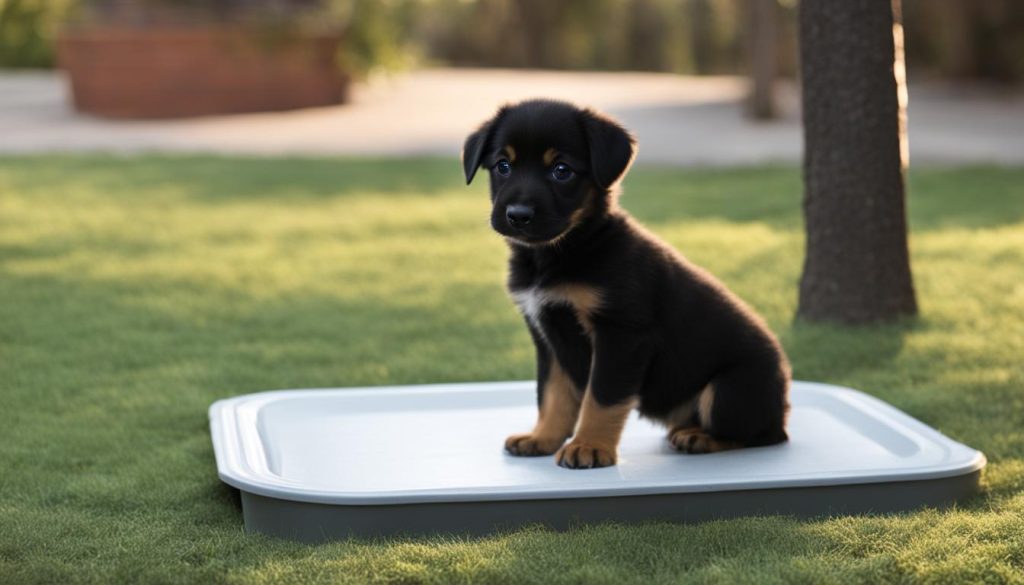
How to Potty Train a Puppy: A Comprehensive Guide
Potty training a new puppy can be a challenging task for any dog owner. However, with proper guidance and techniques, it can be successfully accomplished. Housebreaking your dog is an essential part of their development, ensuring they learn to eliminate in appropriate areas.
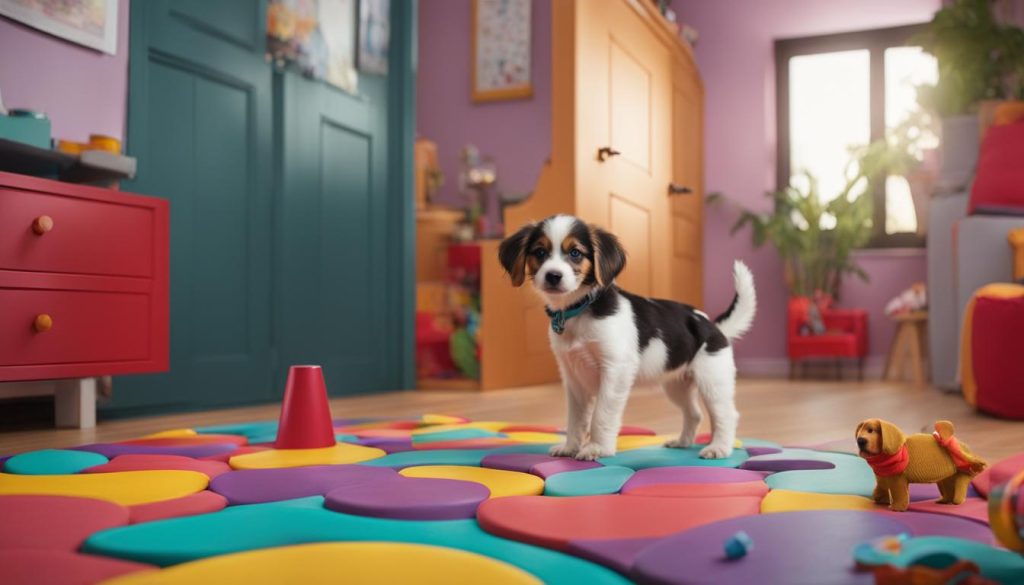
In this section, I will provide you with valuable insights and step-by-step instructions on how to effectively potty train your puppy. By following these tips and being consistent, you can establish good bathroom habits and create a harmonious living environment for both you and your furry friend.
Key Takeaways:
- Patience is key when potty training a puppy, as it takes time for them to develop bladder control.
- Supervise your puppy closely and take them to the designated potty area frequently, especially after waking up, eating, playing, and napping.
- Using a crate can be an effective tool for potty training, as dogs have a natural instinct not to soil where they sleep.
- Consistency, routine, and positive reinforcement are crucial for successful potty training.
- Establishing a schedule and rewarding your puppy for using the designated potty area will help reinforce good bathroom habits.
Be Patient
Potty training a puppy requires patience and understanding. I recommend that you remember that puppies cannot control their bladders until they are around 16 weeks old. Every puppy is different, so the duration of training may vary. I highly suggest that you set realistic expectations and be patient throughout the process.
During potty training, accidents are bound to happen. Instead of getting frustrated, stay calm and handle accidents with patience. Don’t forget that your puppy is still learning and needs your guidance. Use an enzymatic cleaner to clean up accidents and avoid harsh cleaning products that may leave strong scents, as these can attract your puppy back to the same spot.
Consistency is key when potty training a puppy. Stick to a regular schedule and take your puppy to the designated potty area or potty pad at consistent intervals. Watch for signs that your puppy needs to go, such as sniffing or circling. By being patient and consistent, you can help your puppy develop good potty habits and successfully transition into outdoor potty training.
Benefits:
- Puppies learn at their own pace, so being patient allows them to feel comfortable and confident during the training process.
- Patience helps create a positive environment for both the puppy and the owner, reducing stress and frustration.
- Puppies will associate potty training with positive experiences, making them more likely to successfully learn and adapt to the training.
Quotes:
“Patience is key when it comes to potty training a puppy. I recommend that you remember that accidents will happen, and it takes time for puppies to develop bladder control. Stay consistent, be patient, and your puppy will learn.” – Dr. Amanda Smith, Veterinary Behaviorist
Table: Puppy Potty Training Tips
| Tip | Description |
|---|---|
| Set realistic expectations | Understand that puppies cannot control their bladders until they are around 16 weeks old. |
| Handle accidents calmly | Instead of getting frustrated, stay calm and clean up accidents with an enzymatic cleaner. |
| Stick to a consistent schedule | Take your puppy to the designated potty area or potty pad at regular intervals. |
| Watch for signs | Be attentive to your puppy’s behavior to identify when they need to go potty. |
| Use positive reinforcement | Reward your puppy for using the designated potty area or potty pad correctly. |

Supervise at All Times
Potty training a puppy requires constant supervision to ensure their success. By closely monitoring your puppy, you can anticipate when they need to go and guide them to the designated potty area. Taking your puppy to the potty pad frequently, especially after waking up, eating, playing, and napping, will help establish a routine and reinforce positive habits. To make it easier to keep an eye on your puppy, you can use a leash or confine them to a small area.
Timely Bathroom Breaks
One of the keys to successful potty training is to offer regular and timely bathroom breaks for your puppy. By setting a schedule and using a timer to remind yourself to take your puppy to the potty pad, you can prevent accidents and provide them with opportunities to eliminate in the appropriate area. Dogs have different bathroom needs based on their age, so consulting with your veterinarian can help you determine the optimal frequency of bathroom breaks for your puppy.
Recognizing the Signs
I recommend that you observe your puppy’s behavior and learn to recognize the signs that indicate they need to go potty. Sniffing the ground, circling, or becoming restless are common signs that your puppy needs to eliminate. By paying close attention to their body language, you can quickly respond and guide them to the potty pad before accidents happen. Try to always praise and reward your puppy for using the potty pad correctly to reinforce positive behavior.
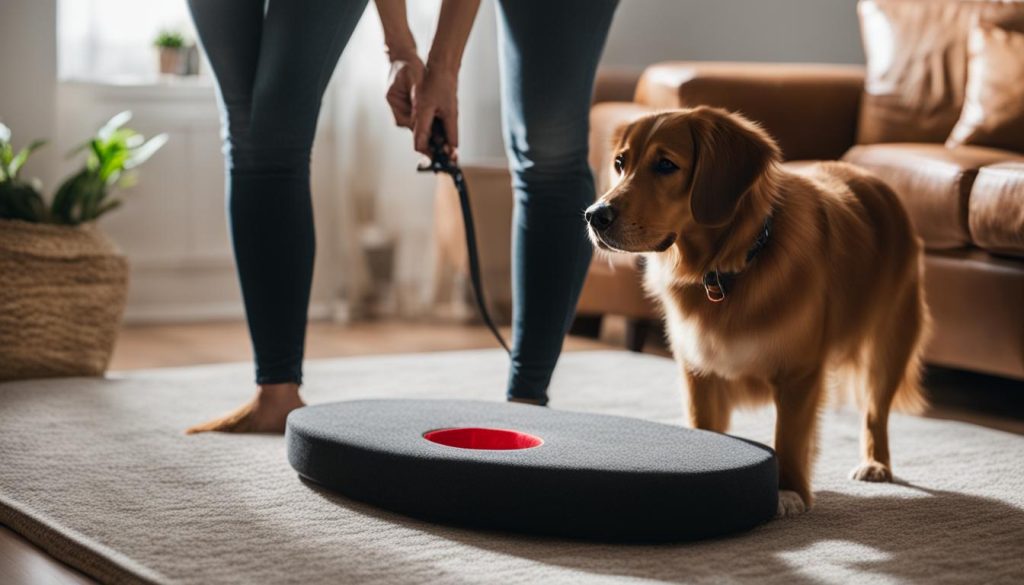
Consistency is Key
Consistency is crucial in potty training puppies. Choose a specific spot for the potty pad and keep it in the same location until your puppy understands its purpose. Establish a routine by taking your puppy to the potty pad at regular intervals and using a consistent command phrase when it’s time to go potty. Reinforce their successes with praise and treats to motivate and encourage them throughout the training process.
Use a Crate
One effective tool for crate training is using a crate for potty training. Dogs have a natural instinct to keep their sleeping area clean, and a crate provides a suitable space for them to hold their bladder. You should choose an appropriately sized crate that is not too large for your puppy or dog, as they may be tempted to eliminate in one corner and sleep in another.

When introducing the crate, associate it with positive experiences by placing treats or toys inside. Make sure the crate is comfortable with bedding or a soft mat. Start by leaving the door open and allowing your puppy to explore the crate on their own. Once your puppy is comfortable, you can begin closing the door for short periods, gradually increasing the duration.
I recommend that you establish a routine and take your puppy straight to the potty pad or designated potty area after letting them out of the crate. This reinforces the association between going outside the crate and eliminating in the appropriate place. Try to reward your puppy for using the potty pad correctly to reinforce the desired behavior.
Be Consistent
Potty training a puppy requires consistency to effectively teach them where to potty. Developing a routine and sticking to it is crucial for success. Create a schedule for taking your puppy to the potty pad at regular intervals throughout the day. By consistently reinforcing this behavior, your puppy will learn to associate the potty pad with their bathroom needs.
Choose a specific location for the potty pad and keep it in the same spot until your puppy understands its purpose. This will help them develop a strong association between the designated area and going to the bathroom. Consistency in location is especially important when transitioning from indoor potty training to teaching your dog to potty outside.
When your puppy successfully uses the potty pad, reward them with praise and treats. Positive reinforcement encourages good behavior and helps your puppy understand that going on the pad is the desired outcome. Try to be patient, as potty training takes time, and consistency is key to achieving the desired results.
Tips for Consistent Potty Training:
- Create a schedule and stick to it, taking your puppy to the potty pad at regular intervals.
- Choose a specific location for the potty pad and keep it consistent until your puppy understands its purpose.
- Use positive reinforcement, such as praise and treats, when your puppy successfully uses the potty pad.
By following these tips and remaining consistent in your potty training efforts, you will help your puppy learn where to go potty and establish good habits for the future.
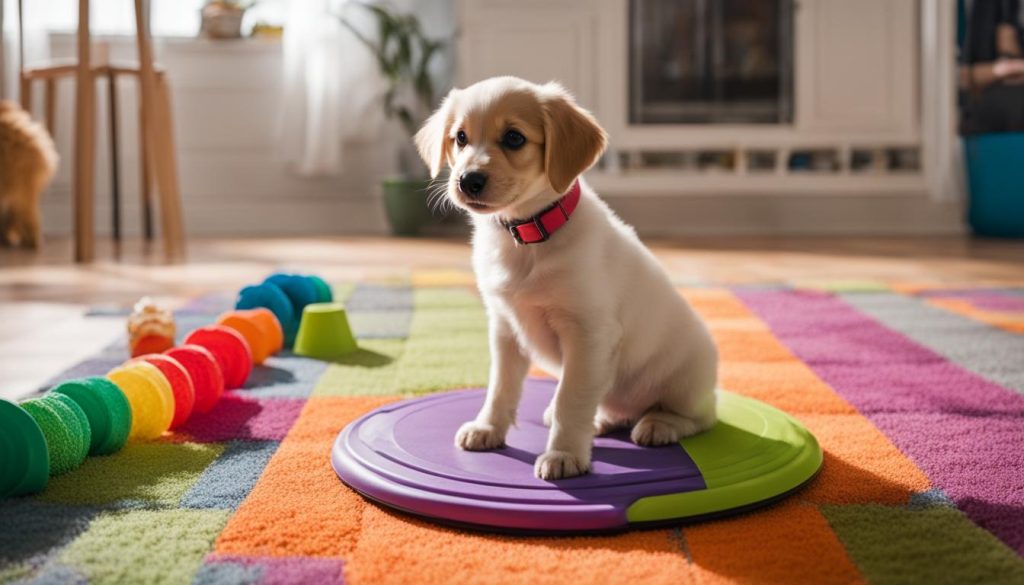
How to Use Puppy Pads for Potty Training
Puppy pad training plays a crucial role in teaching your furry friend where to go potty. Whether you live in an apartment or have limited outdoor access, puppy pads offer a convenient solution for toilet training your dog. With the right approach and consistent training, you can successfully teach your puppy to use these pads and transition to outdoor potty training.

Key Takeaways:
- Introduce your puppy to the puppy pad and use a consistent command phrase for potty time.
- Supervise your puppy closely and take them to the pad frequently, especially after meals, playtime, or naps.
- Reward your puppy with praise and treats for using the pad correctly to reinforce positive behavior.
- Gradually transition from puppy pads to outdoor potty training by moving the pad closer to the door and eventually eliminating it entirely.
- Be patient and consistent throughout the training process, and remember that accidents may happen along the way.
By following these guidelines and providing your puppy with the necessary guidance and reinforcement, you can effectively use puppy pads for potty training. To put it simply, consistency and positive reinforcement are key to successfully toilet training your dog.
Final Thoughts
To sum it up, potty training your puppy to use a pad or designated potty area can be a convenient and effective solution. By following a few key principles, you can successfully teach your dog where to go.
Firstly, patience and consistency are crucial. Puppies take time to develop bladder control, so set realistic expectations and be patient throughout the process. Stick to a regular schedule and take your puppy to the potty pad or designated area at regular intervals, rewarding them for their successes.
Supervision is also essential. Keep a close eye on your puppy and watch for signs that they need to go, such as sniffing or circling. Take them to the potty pad frequently, especially after eating, drinking, waking up, or playing.
Lastly, using a crate can be a valuable tool in potty training. Dogs naturally want to keep their sleeping area clean, so a crate can encourage them to hold their bladder. Choose an appropriately sized crate and associate it with positive experiences. Reward your puppy for going in the crate and immediately take them to the potty pad upon letting them out.
With patience, consistency, supervision, and the right tools, you can successfully potty train your puppy and teach them where to go. Try to celebrate their successes and be patient with any setbacks along the way. Happy training!
FAQ
How do I teach my dog to poop on a pad?
Start by training your dog to go to the bathroom on command and introduce the potty pad in a suitable spot. Reward your dog’s successes and stay consistent with the training until they learn to use the pad.
Why should I use pee pads?
Pee pads can be beneficial in various situations such as traveling, leaving your dog at home for extended periods, crate training, house training puppies, and training senior dogs. They can prevent accidents and make potty training easier.
How do I teach a dog to use potty pads?
Find a suitable spot for the potty pad and introduce it to your dog, using a consistent word cue. Guide your dog to the pad if necessary and reward their successes. With time and consistency, your dog will learn to use the potty pad.
What are the best pee pads for my dog?
Consider factors such as size, absorbency, and preferences. Frisco Extra Large Dog Training & Potty Pads are a popular option, while the Four Paws Wee-Wee Dog Grass Patch Tray offers a grass-like surface. Choose a pee pad that suits your dog’s needs.
What are common potty pad training mistakes?
Lack of training and expecting the dog to know where to go without guidance is a common mistake. Consistency and underestimating dogs’ bathroom needs can also hinder the training process. You should handle accidents calmly and use an enzymatic cleaner for cleaning.
How do I potty train a puppy?
Potty training a puppy requires patience, supervision, and positive reinforcement. Use a crate to help with housebreaking and establish a consistent routine. Be patient with your puppy’s progress as they develop bladder control.
How do I supervise a puppy during potty training?
Keep a close eye on your puppy and take them to the potty pad or designated area frequently, especially after waking up, eating, playing, and napping. Use a leash or confine your puppy to a small area to ensure supervision.
How do I use a crate for potty training?
Choose an appropriately sized crate for your puppy and associate it with positive experiences. Dogs generally don’t like to soil where they sleep, making the crate an effective tool for potty training. Reward your puppy for going in the crate and take them straight to the potty pad after letting them out.
How important is consistency in potty training?
Consistency is crucial for successful potty training. Develop a schedule and take your puppy to the potty pad at regular intervals. Choose a specific place for the pad and keep it in the same location until your puppy learns its purpose. Reward your puppy for using the potty pad correctly.
How do I use puppy pads for potty training?
Allow your puppy to familiarize itself with the pad and use a consistent command phrase when it’s time to go potty. Supervise your puppy closely and take it to the pad frequently, rewarding them for using it correctly. Gradually transition to outdoor potty training.
How do I teach my dog to poop on a pad?
Start by training your dog to go on command, find a suitable spot for the pad, introduce the pad to your dog, and reward their successes. Choose the right pee pads for your dog and avoid common training mistakes. Be patient, supervise your puppy, use a crate, and stay consistent.






